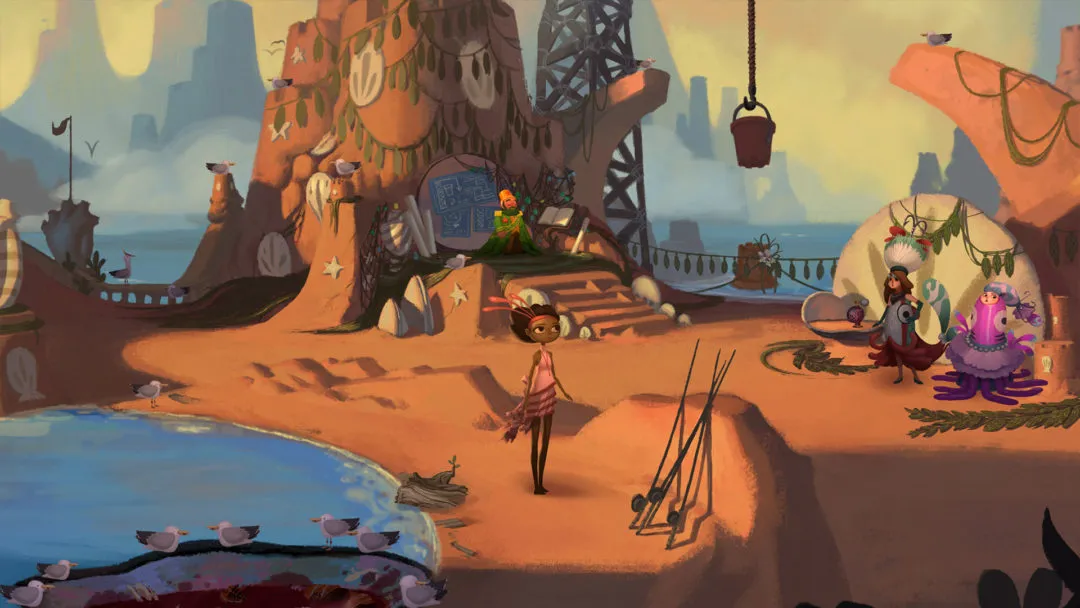It’s been seven years since Tim Schafer kicked off the nostalgia-fueled video game crowdfunding craze with Broken Age. It wasn’t the first game on Kickstarter, but it was the first major success story. That success provided a way for players to collectively evade the gatekeepers running the major publishers. This solved a major funding problem in gaming, while also creating a few new ones.
Game budgets have been climbing since the invention of the medium. In the early days, a single person could create a viable commercial video game in a couple of weeks. Today, the top games take hundreds of people working for years. The big publishers have mostly gone along with this. The people in charge of funding games want to spend big and win big, so they push for better graphics and Hollywood-style production values. I don’t think this is always a sound investment. The extra money doesn’t necessarily translate into a better gaming experience or more sales. Instead a lot of money is being wasted in the name of trying to make money, but let’s not have that discussion again.
This obsession with big budget tentpole releases leaves a gap in the middle of the market. The small-time indie scene creates games for tens of thousands of dollars. The big publishers make games for tens of millions. Between these two extremes is a space where a lot of niche products belong. There aren’t really enough fans of fussy turn-based roleplaying games to support a huge $50 million blockbuster, but you also can’t make those kinds of games on the cheap without major sacrifices in terms of visuals and depth. Some genres and audiences are ideally suited to projects in the $100,000 to $5 million range. That’s too big for an individual to fund, but too small for a major publisher to care about. Kickstarter bridges this gap by allowing fans to fund games directly.
Once Broken Age showed that there was an audience for old school genres, a new wave of starry-eyed indies showed up with dreams of being part of the next Kickstarter success story. This began an ever-evolving metagame between the gaming public and the people who wanted access to their money.
When you back a project, you’re technically an investor, not a consumer. A consumer is guaranteed to receive a product for their money, while an investor has no such assurances. If 50,000 people all donate $20 to a project as investors, they have a lot less up front negotiating power than a single backer putting up a million dollars. This creates a challenging lack of accountability in crowdfunded projects.
A publisher or private investor can negotiate for development milestones in the schedule such as, “The project will have X features by Y date.” They can ask for development builds to review progress for themselves and they can even choose to visit the developers personally and ask questions to make sure work is getting done on time. If the backer finds that the developer has been negligent with the money, they have lots of options. A publisher can close the studio or fire people. An investor can withhold further funding. They have a contract that gives them a lot of leverage in case legal action is needed.
A crowd of disorganized backers has no such protections. They have no direct access to the game, so they can’t audit the developer’s work to make sure the project is on schedule. That doesn’t matter anyway since they have almost no power to punish the team if it looks like they’ve been wasting money. They can’t threaten the studio with closure, they can’t fire anyone, and their legal options are much more limited.
All of this makes the crowdfunding scene very attractive to opportunists. That first surge of indie Kickstarter projects created a bit of a bubble, which resulted in a lot of failed projects. I remember a period of a year or so where my inbox was constantly bombarded with solicitations to promote or support various indie pipe dreams. A lot of those projects vanished without producing anything useful. Some projects failed when the idealistic young hopefuls discovered that making a pitch video is a lot easier than making a full game. Other projects failed because the developer took the money and ran. From the standpoint of an outsider, it’s really hard to tell the difference between a team that ran out of money because they were inexperienced at project management and a team that took the money and goofed off for a year.

The failed games made fans cautious. People stopped throwing money at every project selling itself on nostalgia and good pixel art. The demand for niche and retro gaming experiences was still there, but the lack of trust and accountability was interfering with the crowdfunding process. Developers adapted to the new meta by leveraging established names and talent. Brian Fargo used his name to get Wasteland 2 funded. The Pillars of Eternity pitch video featured industry luminaries Chris Avellone, Tim Cain, and Feargus Urquhart. These were some of the biggest names behind 1990s roleplaying games, and their presence helped reassure potential backers that their respective teams had the skills to successfully bring these classic games into the new millennium.
This brings us to the latest evolution of the crowdfunding system. Teams use IP or individuals with lots of prestige to get funded. Then instead of making the game directly, they use the money to build a demo, and use the demo to chase the backing of traditional venture capitalists. It’s tough to get a sense of how common this practice is, but I want to talk about two cases in particular.
Back in 2016, Nightdive Studios acquired the rights to the System Shock franchise and pitched a remake to potential backers. They had a demo that showed the environments and gameplay of the 1994 original, faithfully recreated using modern tools. Once they hit their funding target, they threw away the demo that had been used to attract backers and started the entire project over using the Unreal Engine. The new design was no longer a 1:1 remake of the original, but instead a complete reimagining of the game with modern AAA production values. This idea is less like the various “remasters” we’ve had over the years, and more like modern adaptations such as 2016’s Doom and Wolfenstein: The New Order.
This move effectively trapped the entire project. The money from backers wasn’t going to be anywhere near enough to complete the game with this expensive new design. The project would need an even larger infusion of cash or it was going to run out of money. Instead of creating the game that was promised to backers, Nightdive took the money and used it to create a AAA-style demo for prospective publishers. The publishers ultimately passed on System Shock, and the project went on hiatus.

To be fair to Nightdive, the team did return to the original concept and is once again working on a faithful remake. To be fair to the backers, Nightdive didn’t come back to them until they ran out of options with publishers. It’s nice that they did the right thing, but it’s somewhat concerning that they didn’t do the right thing until it was the only option they had left.
This project falls into a very murky grey area. Technically they promised to make a System Shock game, and that’s what they attempted to do. But you can imagine what the reaction would have been if their initial pitch had said, “Here’s a remake of the first level of System Shock, but we’re not going to make an old-school game like this. We want your support so we can make a completely unrelated proof-of-concept modern AAA demo that we can shop around to publishers.” I doubt people would have been in a hurry to back the project.
The other project I want to look at is Phoenix Point, which is being billed as a spiritual successor to the original X-Com games. While 2012’s XCOM: Enemy Unknown did really well for a turn-based game, some fans of the original from 1994 feel that the newer title lacks its depth and charm. Phoenix Point is looking to fill that niche. The team features Julian Gollop, who designed the original X-Com: UFO Defense. Developer Snapshot Games launched a crowdfunding campaign back in 2017 which easily shot past its original funding goal, raising 153% of the requested $500,000.
The initial campaign promised that backers would be able to play the game on GoG and Steam. Later the team announced that the game was going to be exclusive to the Epic Games store for a full year. Snapshot Games was given an infusion of cash from Epic in exchange for this timed exclusive, and the company calculated that the money was worth angering a few fans. Predictably, the community was very unhappy with this announcement. But Epic Games provided enough cash that Snapshot could have refunded every backer and still been ahead financially.
Snapshot Games offered refunds to backers who were unhappy with the altered deal, and has been quick to point out that very few people took them up on the offer. That puts a good face on the situation, until you realize that getting the refund wasn’t an automated system. Supporters needed to contact the company directly, and they needed to provide their full bank credentials to get their money. That’s both a hassle and a risk, and it’s not unreasonable to think that a lot of people who wanted the refund were unwilling to ask for it without the usual layers of transactional security we’re accustomed to on the internet.
In both cases, we have companies that appealed to a small group of nostalgic fans to get their initial funding, and then betrayed them when they saw a chance to get cash from a major publisher. Snapshot’s plan was a success while Nightdive’s plan was ultimately a failure, but both companies used crowdfunding cash as a stepping stone to secure more traditional funding.
The Phoenix Point team was probably happy to get a nice big check from Epic Games, but this move ultimately erodes everyone’s trust in the crowdfunding scene. Backers are looking for a niche mid-budget game that wouldn’t normally get traditional publisher support. If the developer embraces publisher control in exchange for money, then they’re defeating the entire purpose of the system.
Like I said earlier, crowdfunding is the only way some games can get made. What’s the next hopeful team supposed to do? Those bad faith efforts make it hard to reassure customers by saying “No, trust us. We’re not like those other companies. We don’t want millions of dollars from the publishers. We just want to make this small game.” Even if they’re sincere, there’s no good way to prove this.





Published: Mar 26, 2019 09:28 am